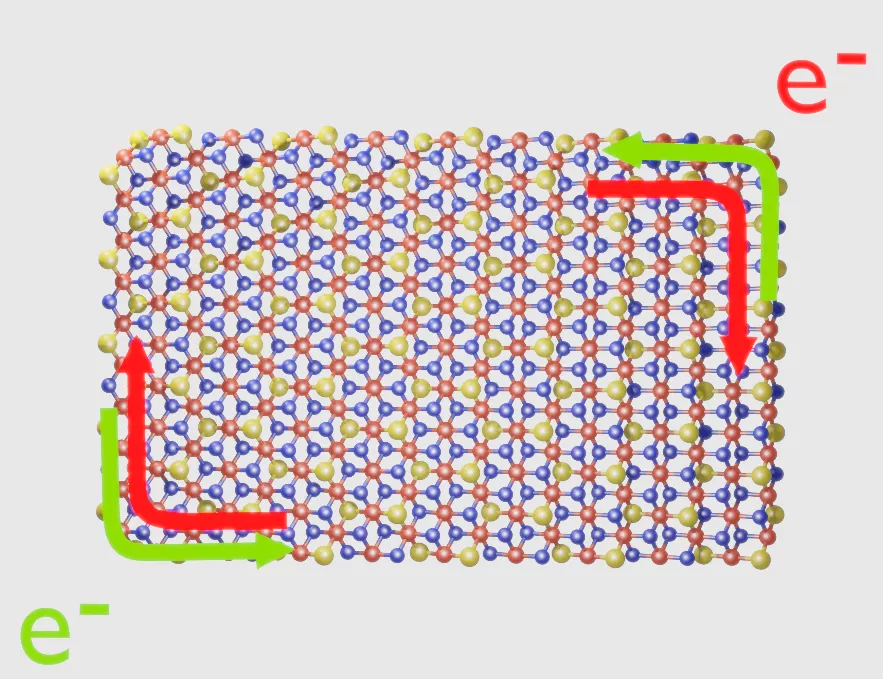The Topology in Nanostructures, “Lendület” Group led by Péter Nemes-Incze within the Institute of Technical Physics and Materials Science of the Centre for Energy Research, has shown that a two-dimensional crystal of heavy metals, Jacutingaite, may be suitable for lossless electrical conduction even at room temperature. In the future, the newly discovered topological insulator may play an important role in the design of low-power electrical circuits and may also be used in topological quantum computers in combination with superconducting materials.
Over the past 10 years, the scientific community has made significant efforts to explore topological insulators in which lossless electrical conduction can be observed even at room temperature. This was the goal set by the “Lendület” Group, and a significant breakthrough has been achieved in cooperation with the Wigner Physics Research Centre, the Department of Biological Physics at Eötvös Loránd University and the Czech Geological Institute. The focus of experimental and theoretical research was a naturally occurring mineral, platinum-mercury-selenide (Pt2HgSe3, known by its scientific name of Jacutingaite).
It is widely known that the discovery of graphene – a two-dimensional, atomic-scale crystal – has given a whole new direction to research in materials science. The study of layered 2D materials has held out hopes for significant new discoveries and potential practical applicability ever since. Perhaps it is less well known that graphene was a starting point for an equally important, new area of research: two-dimensional topological insulators.
Topological insulators are crystals that behave as electrical insulators in their interior and conduct electrical current on their surface and edges. An important feature of these conductive channels is that they conduct electricity without loss, in contrast to conventional electrical conductors such as copper or aluminum. In 2005, theoretical calculations by Charles Kane and Eugene Mele showed that graphene is in fact a topological insulator, if one takes into account that the electrons moving inside it behave like a small magnet, called a spin. Unfortunately, it is almost impossible to observe lossless electrical conduction at the edges of graphene in practice, as an important parameter of the Kane-Mele model – the so-called spin-orbit coupling – is negligible in carbon atoms forming graphene. As a result, the observation of topological electron conduction in graphene requires ultra-low temperatures (micro-Kelvin), not yet possible in laboratories.

Figure: Spin-polarized, conducting channels (red: up spin, green: down spin) at the edges of the Pt2HgSe3 crystal
The mineral studied in the research project received its name from the Brazilian gold mine (Jacutinga), where it was first found around ten years ago. The substance can already be produced artificially – and such crystals have been studied by the Hungarian researchers. The platinum and mercury atoms that make up the compound are located in a hexagonal lattice, similar to graphene. This honeycomb lattice of heavy metals determines the electrical properties of the crystal. The main difference compared to graphene is that, unlike carbon, the spin-orbit interaction of mercury and platinum is orders of magnitude stronger.
A student working in the “Lendület” Group has been able to show that the material, like graphite, can be separated into individual atomic layers using techniques already well known from graphene research. The researchers have examined the electrical properties of the material on an atomic scale using scanning tunneling microscopy measurements. As a result, topological, electrically conductive edge channels were detected at the edges of the crystal, and it was also found that, due to the high spin-orbit interaction, this material behaves as a topological insulator even at room temperature, in contrast to graphene. Essentially, platinum-mercury-selenide is an example of the long-sought-after Kane-Mele insulator.